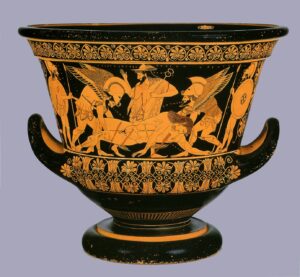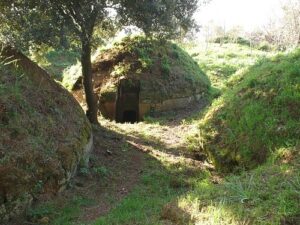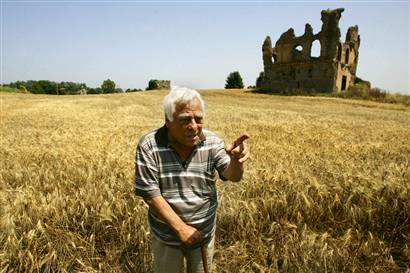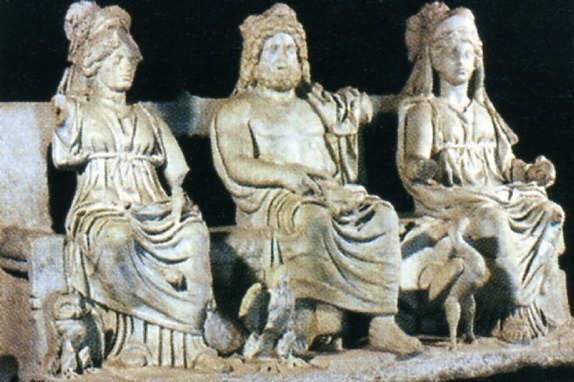Tomb-robbing has been called the world’s second oldest profession.

Italy, with over forty UNESCO World Heritage sites, is a particular target, but it is a plague that increasingly affects other countries such as Peru, Guatemala, Mexico, China, Thailand, Turkey, Egypt and Greece, where poverty, poor security, the buried remains of a rich civilisation and seemingly insatiable demand from unscrupulous dealers and collectors have conspired to rapidly destroy thousands of years of our shared archaeological and historical heritage for profit.
To the trained tombarolo eye (although the word “tombarolo” comes from “tomba,” Italian for tomb, it is used to describe all antiquities looters), hidden tombs can be identified by changes in the colour of the grass and variations in the patterns of vegetation, since grass growing above a hollow space dries more quickly and grows more sparsely. Other clues include wild fig trees, which often grow directly above tombs, brambles growing tall and yellowish, where the roots are resting on buried walls, and fox and mole tracks, which can be traced to underground burial chambers where the animals like to make their burrows.
Having identified a suitable spot, a quick survey is carried out by using a spilloni (long metal pole) to work out the rough outline of the tomb, where the entrance is and how deeply buried it is. The spot is then marked with a pile of stones or plastic bag, anything will do, before a larger group of men returns at night.

Breaking into a tomb usually takes two nights. On the first, enough earth is cleared away to allow ventilation of the interior chamber and to allow whatever is inside, which may have lain buried for as long as 2,600 years, to oxidise and harden. On the second night, the tombaroli return to the site. They use no flashlights or torches of any kind and prefer to work when the moon is low, their caution extending to lighting cigarettes under their coats and then smoking them backwards, placing the lit end inside their mouths.
The tombaroli have six to eight hours of darkness to get the job done. It is hard, manual labour. Three men will dig with shovels as a fourth stands guard above, scaning the fields with infra-red binoculars and fuelled by coffee and whisky to keep them awake. Once any artefacts have been removed from the burial chamber, the tombaroli wrap them carefully in newspapers, place them in plastic bags and hide them in clumps of trees nearby rather than risk being caught in possession. On average, a virgin tomb will yield some 30-40 vases as well as an assortment of other artefacts, although many of the tombs have already been looted, either in antiquity or more recently.
Once a tomb has been looted, the tombaroli usually do not come back, unless the site is well hidden and no farmers live nearby. Objects found typically include vases, statuettes, mirrors, ornaments, jewellery, and other pieces in gold, bronze, and terracotta. Counter-intuitively bronze objects are valued more than those in gold because gold is impossible to date and so difficult to establish as authentic.
One of Italy’s most famous tombarolo is Pietro Casasanta. When he wasn’t in prison, the convicted looter operated for decades in the countryside outside Rome, often in broad daylight with a bulldozer posing as a construction worker, unearthing statues, pottery and other artifacts which he then sold for millions of dollars into the illegal antiquities market.

His greatest find was a 4th-century-B.C. ivory mask representing the Greek god Apollo which he unearthed in 1994 [see Apollo ivory mask]. He found it at a site a few hundred yards from a well-known archaeological landmark, the Baths of Claudius, and mainatins that the statue came from a villa that belonged to the family of the first-century Roman Emperor, Claudius.
Since he began digging illegally, in 1960, he claims to have discovered about a hundred villas and, before finding the ivory head, his greatest claim to notoriety was his discovery, in 1970, of L’Inviolata, a large settlement, a temple cult, which he says contained 63 statues, 25 of them life-size. He returned to L’Inviolata in 1992 when he discovered the famous ‘Capitoline Triad’, a six-ton marble statue of three seated gods – Jupiter, Juno and Minerva – that is now in the Palestrina National Archaeological Museum, southeast of Rome. This is the only marble sculpture in which the three gods of the Triad are intact.

Now 69, ailing and leaning heavily on a cane, Casasanta lives in a small house in Anguillara, which juts out into the waters of Lake Bracciano. Many townspeople address him admiringly as “professore” when they find him chain-smoking at a cafe table along the lake shore. He still insists that he only dug up treasures in areas that were threatened by development projects that would have destroyed the ancient artifacts. Experts, however, point out that the tombaroli are a threat to Italy’s cultural heritage not only because their finds disappear abroad, but also because their digging methods are often brutal and damaging.
For years the tombroli have operated with almost no interference – the Italian police, faced with competing (and politically higher priority) challenges from organized crime and political terrorism, simply don’t have the manpower to patrol the vast number of unexcavated sites and territory required to keep the tomb-robers’ activities in check. The Carabinieri are still seeking more than 2.5 million missing objects registered in the art squad’s database. In archaeological circles the attitude is largely defeatist, with talk of tomb-robbing as an inevitability.
And yet over the last decade Italy has launched an all-out crackdown. Increased monitoring of archaeological sites has landed diggers like Casasanta in jail and the unravelling of the Medici network [click here for more] has led to the seizure of treasure-filled warehouses in Switzerland. More importantly, the authorities’ attention has switched from targetting the supply to fixing their sights on the demand side of the equation, by successfully pressuring some U.S. museums to return looted artifacts. Their efforts have scared museums, collectors and the international art market into following stricter guidelines for acquisitions and cutting ties with dealers suspected of buying from the tombaroli. Buyers are also concentrating more on objects coming from private collections or other legitimate sources. The collapse in demand has made tomb-robbing far less profitable than it used to be, and triggered a sharp fall in activity – In 2006, the Carabinieri discovered fewer than 40 illegal digs, compared to more than 1,000 a year in the late 1990s.




